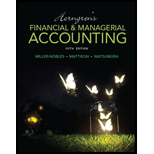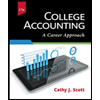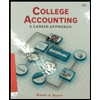
Concept explainers
(1)
Accounts receivable
Accounts receivable refers to the amounts to be received within a short period from customers upon the sale of goods and services on account. In other words, accounts receivable are amounts customers owe to the business. Accounts receivable is an asset of a business.
Bad debt expense:
Bad debt expense is an expense account. The amounts of loss incurred from extending credit to the customers are recorded as bad debt expense. In other words, the estimated uncollectible accounts receivable are known as bad debt expense.
Allowance method:
It is a method for accounting bad debt expense, where uncollectible accounts receivables are estimated, and recorded at the end of particular period. Under this method,
Write-off:
Write-off refers to deduction of a certain amount from accounts receivable, when it becomes uncollectible.
To journalize: The given transactions using allowance method.
(2)
the ending balance of accounts receivable, allowance for bad debts, and bad debt expense using T-account.
(3)
To show: The way of reporting accounts receivable on the balance sheet as at December 31, 2016.
Want to see the full answer?
Check out a sample textbook solution
Chapter 8 Solutions
Horngren's Financial & Managerial Accounting (5th Edition)
- Please explain this financial accounting problem with accurate financial standards.arrow_forwardAt the beginning of the recent period there were 1,020 units of product in a department, one-third completed. These units were finished and an additional 5,500 units were started and completed during the period. 840 units were still in process at the end of the period. One-fourth completed. Using the weighted-average valuation method the equivalent units produced by the department were: A. 6,730 units B. 6,680 units C. 7,360 units D. 6,390 Units E. 8,250 unitsarrow_forwardWhat is the value of inventory listed on the firm's balance sheet?arrow_forward
- MCQarrow_forwardA manufacturing company applies overhead based on direct labor hours. At the beginning of the year, it was estimated that overhead costs would be $460,000 and direct labor hours would be 91,000. Actual overhead costs incurred were $458,000 and actual direct labor hours were 96,000. What is the amount of overapplied or underapplied overhead at the end of the year? A. $16,000 overapplied B. $16,000 underapplied C. $26,800 overapplied D. $9,000 underappliedarrow_forwardI am looking for the correct answer to this general accounting question with appropriate explanations.arrow_forward
 Financial Accounting: The Impact on Decision Make...AccountingISBN:9781305654174Author:Gary A. Porter, Curtis L. NortonPublisher:Cengage Learning
Financial Accounting: The Impact on Decision Make...AccountingISBN:9781305654174Author:Gary A. Porter, Curtis L. NortonPublisher:Cengage Learning College Accounting (Book Only): A Career ApproachAccountingISBN:9781337280570Author:Scott, Cathy J.Publisher:South-Western College Pub
College Accounting (Book Only): A Career ApproachAccountingISBN:9781337280570Author:Scott, Cathy J.Publisher:South-Western College Pub College Accounting (Book Only): A Career ApproachAccountingISBN:9781305084087Author:Cathy J. ScottPublisher:Cengage Learning
College Accounting (Book Only): A Career ApproachAccountingISBN:9781305084087Author:Cathy J. ScottPublisher:Cengage Learning Cornerstones of Financial AccountingAccountingISBN:9781337690881Author:Jay Rich, Jeff JonesPublisher:Cengage LearningPrinciples of Accounting Volume 1AccountingISBN:9781947172685Author:OpenStaxPublisher:OpenStax College
Cornerstones of Financial AccountingAccountingISBN:9781337690881Author:Jay Rich, Jeff JonesPublisher:Cengage LearningPrinciples of Accounting Volume 1AccountingISBN:9781947172685Author:OpenStaxPublisher:OpenStax College





